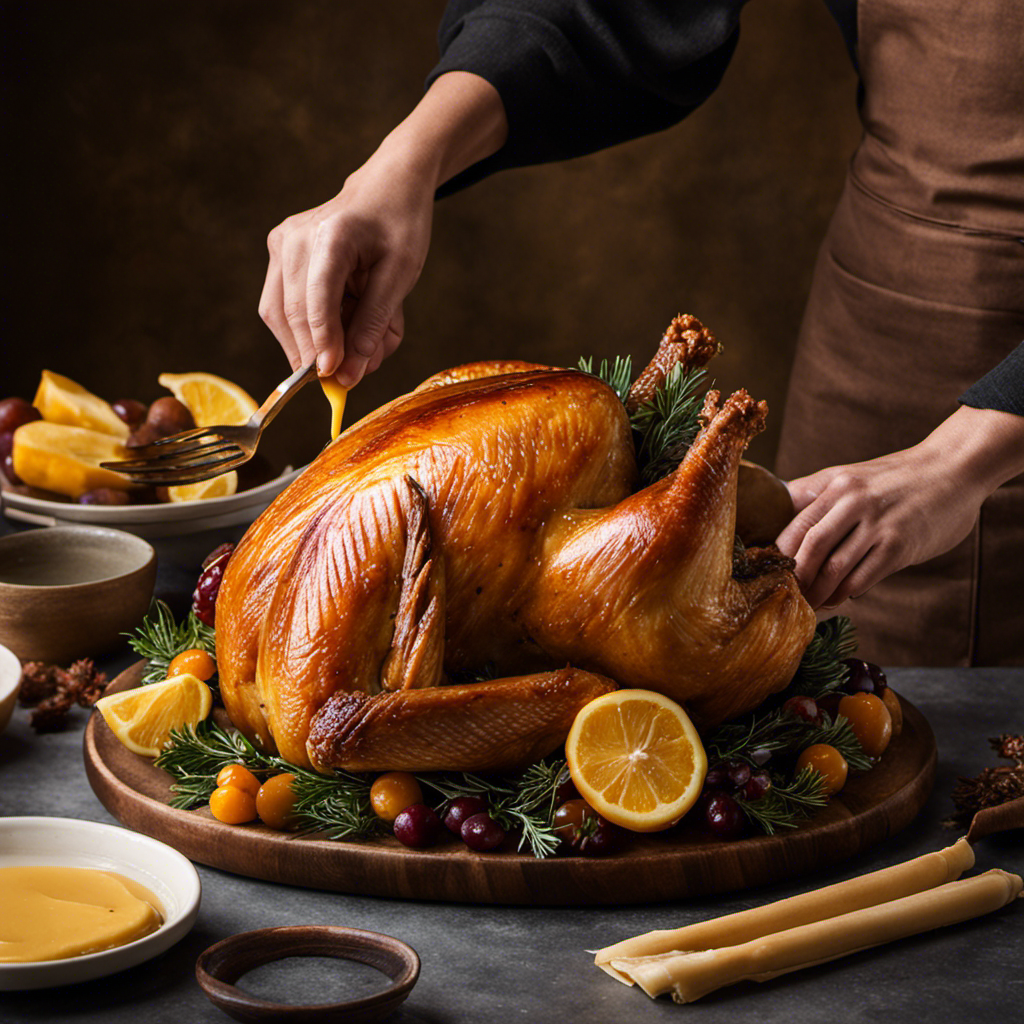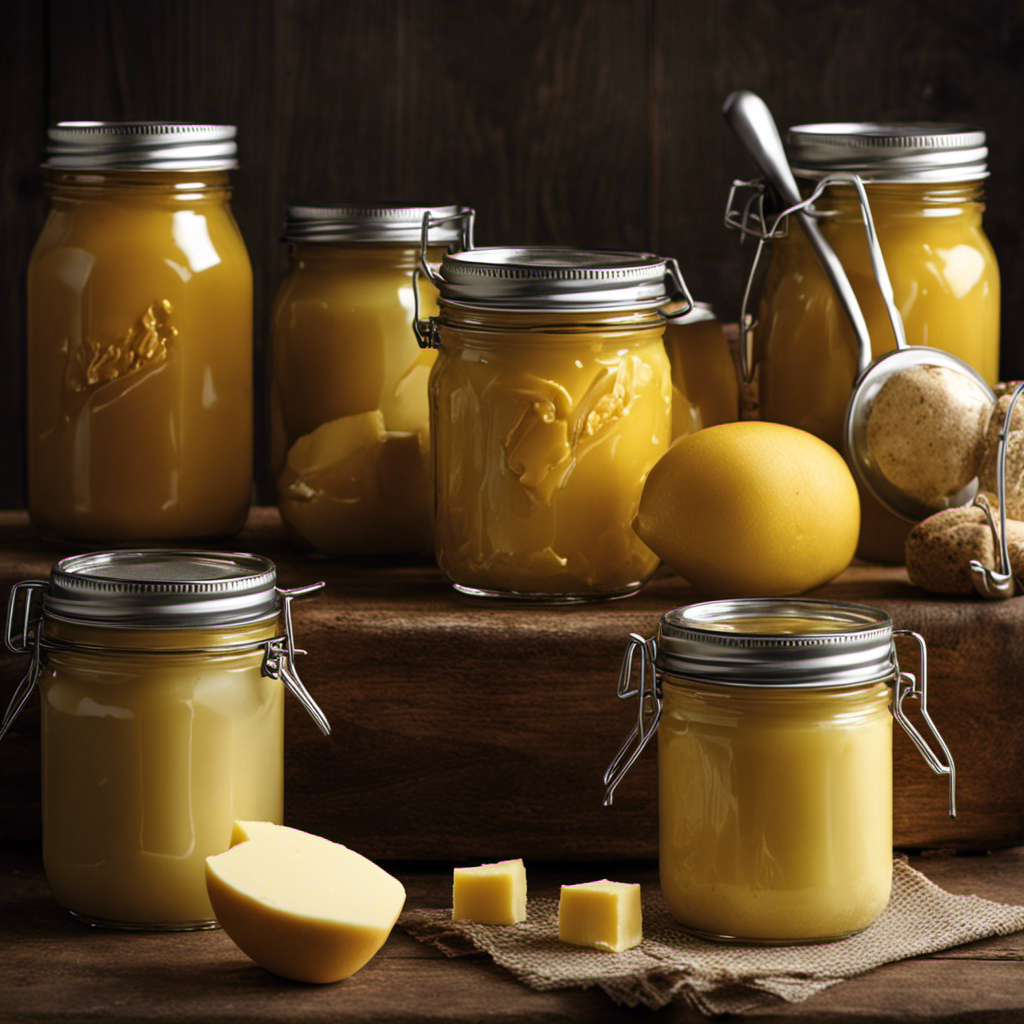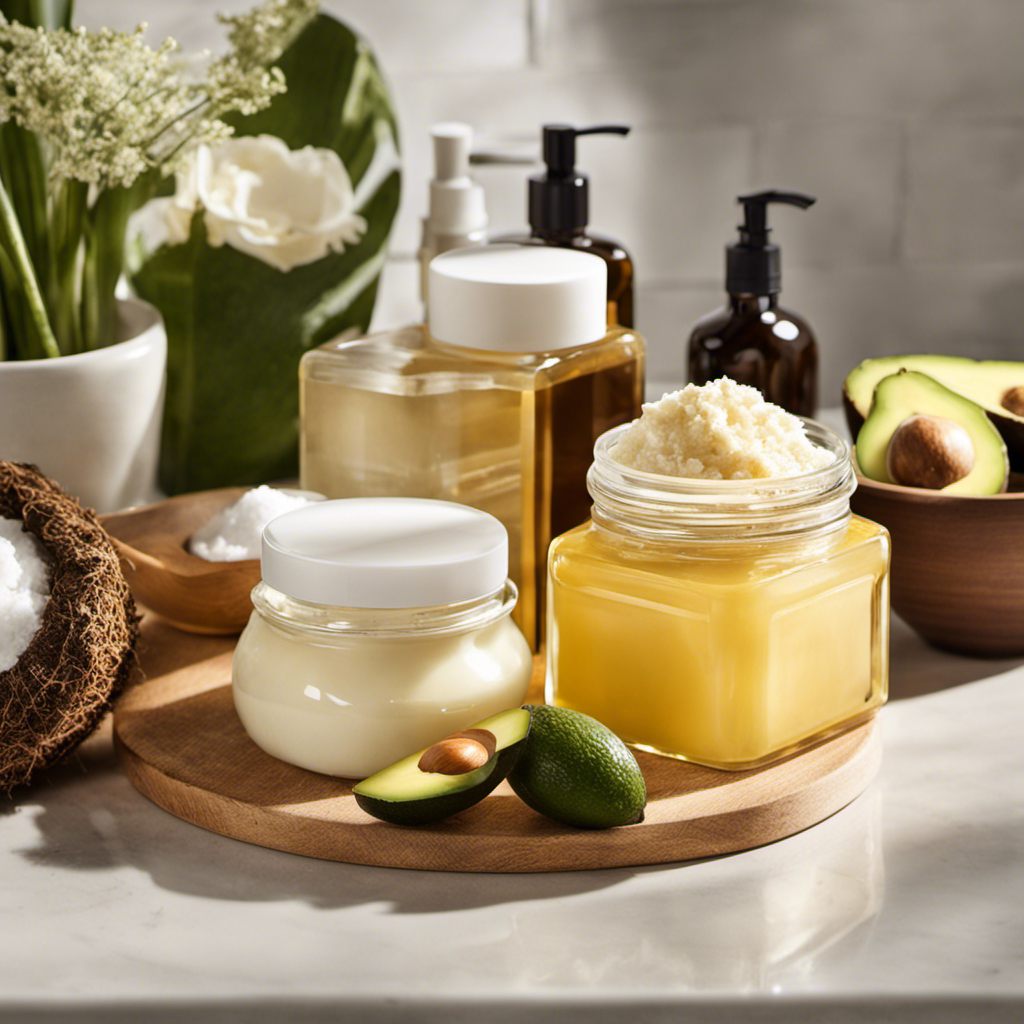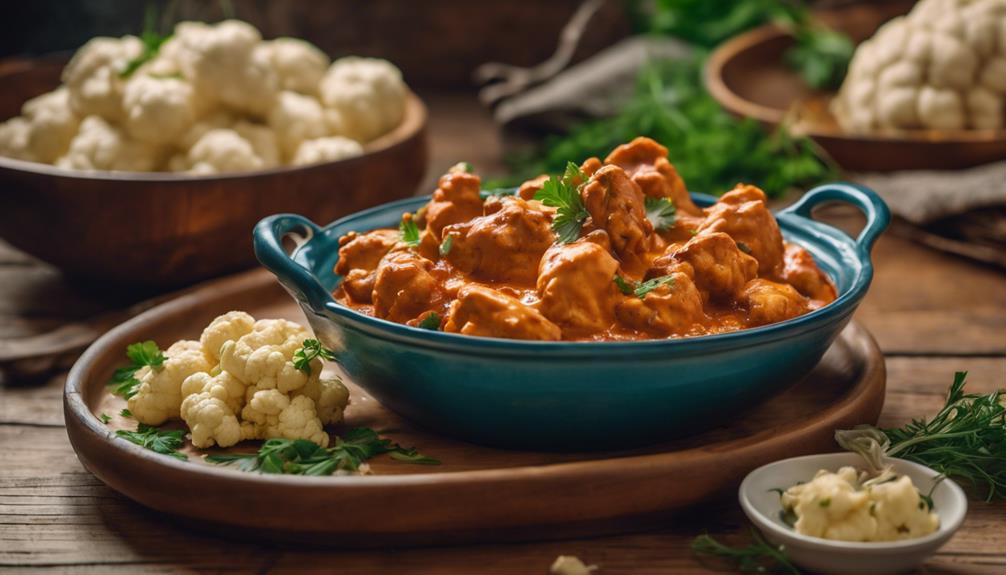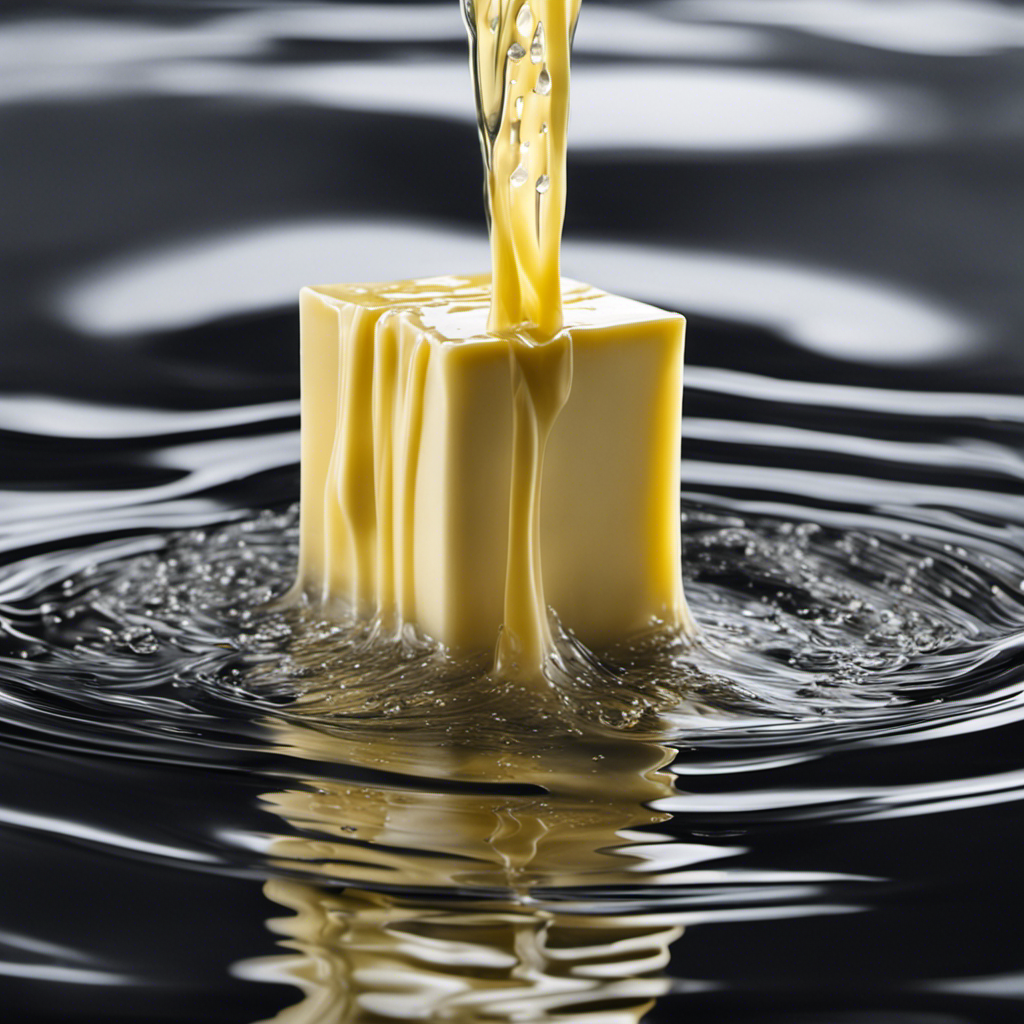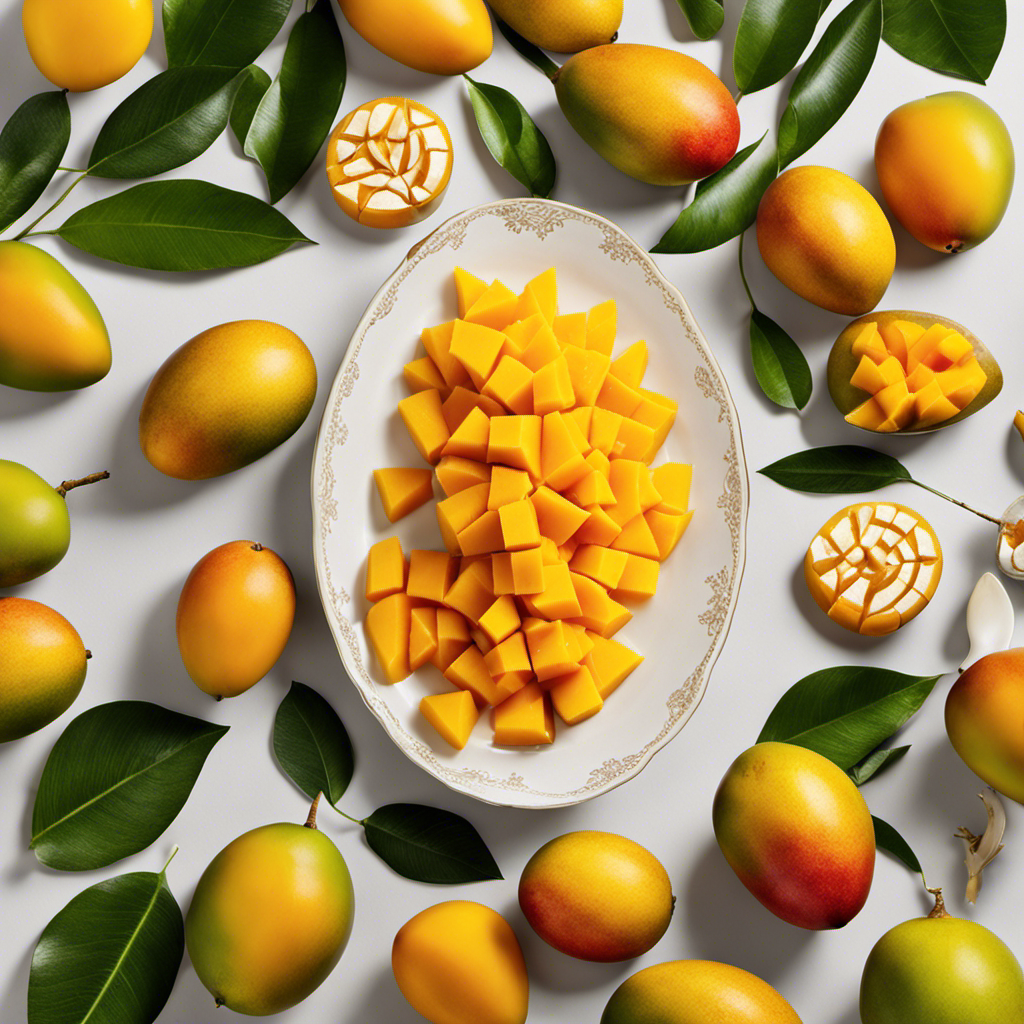In my bustling kitchen, the aroma of Thanksgiving fills every nook and cranny. The idea of a perfectly basted turkey fills me with joy. As I carve each slice, memories of love and commitment associated with this timeless tradition come flooding back.
In this article, I will guide you through the art of buttering a turkey, sharing my tips and expertise to ensure a succulent and flavorful centerpiece for your holiday feast. So let’s dive in and unlock the secrets to a beautifully buttered turkey.
Key Takeaways
- Softened butter at room temperature is essential for easy spreading and even coating.
- Proper seasoning with salt, pepper, and desired herbs or spices enhances flavor.
- Softened butter should be left at room temperature for about 30 minutes.
- Rub softened butter on the turkey’s skin and spread flavored butter mixture inside the cavity.
Gathering the Necessary Ingredients
Now that you’ve got your turkey ready, it’s time to gather all the necessary ingredients for buttering it.
The key ingredient for this step is softened butter at room temperature. Softened butter is essential because it spreads easily and evenly, ensuring that every part of the turkey is coated in a rich and flavorful layer of butter.
To soften the butter, leave it at room temperature for about 30 minutes or until it is soft to the touch. Avoid microwaving the butter as it can melt unevenly or become too soft.
Softened butter is not only easier to work with, but it also helps to keep the turkey moist and adds a delicious buttery taste to the final dish.
Preparing the Turkey for Buttering
When it comes to preparing the turkey for buttering, there are a few key things to keep in mind.
First, the temperature of the butter is crucial in achieving the perfect spread. The butter should be softened to room temperature, making it easier to work with and ensuring a smooth application.
Additionally, proper seasoning before buttering is essential for maximum flavor. This can be done by generously seasoning the turkey with salt, pepper, and any other desired herbs or spices.
Temperature for Buttering
To get started, you’ll want to make sure the butter is at room temperature before applying it to the turkey. This is important because room temperature butter is easier to spread evenly and will create a smooth and consistent layer on the turkey.
Here are three tips to ensure the butter is at the right consistency:
-
Take the butter out of the refrigerator at least 30 minutes before you plan to use it. This will allow it to soften and reach room temperature.
-
Cut the butter into small cubes or slices. This will help it soften more quickly and evenly.
-
If you’re short on time, you can microwave the butter for a few seconds at a time, checking and stirring it frequently until it reaches room temperature.
Proper Seasoning Before
Make sure you generously season your bird with salt and pepper before cooking it. Proper seasoning techniques are crucial to enhancing the flavor of your turkey.
Start by patting the turkey dry with paper towels, ensuring that the skin is completely dry. This will help the seasoning adhere better to the surface.
Next, sprinkle a generous amount of kosher salt and freshly ground black pepper all over the turkey, both on the inside and outside. Don’t be afraid to season it liberally, as the flavors will infuse into the meat during cooking.
For an extra punch of flavor, consider marinating the turkey overnight in a mixture of herbs, spices, and aromatics. This will further enhance the taste and tenderness of the meat.
Techniques for Even Spread
For an evenly distributed seasoning, gently rub the mixture onto the skin, making sure to cover all areas of the bird. Achieving an even spread of butter on a turkey is essential for a flavorful and moist result. Here are three techniques to ensure a perfect buttering:
-
Soften the butter: Allow the butter to come to room temperature before starting. This will make it easier to spread evenly and prevent tearing the skin.
-
Use your hands: Take a small amount of softened butter in your hands and rub it all over the turkey, making sure to get into all the nooks and crannies. This allows for better control and coverage.
-
Apply in layers: Rather than slathering all the butter at once, apply it in thin layers. This helps to build up flavor and ensures an even distribution.
By following these even spread techniques and buttering tips, you’ll achieve a beautifully buttered turkey that is both succulent and delicious.
Now, let’s move on to the next step: softening the butter.
Softening the Butter
When it comes to softening butter, there are a few key points to keep in mind.
First, room temperature butter is ideal for most baking recipes, as it incorporates more easily into the dough or batter.
If you’re short on time, you might be tempted to use the microwave, but I’ve found that using the stovetop method yields better results, as it allows for more controlled softening.
Room Temperature Butter
Spread the soft, room temperature butter all over the turkey for a deliciously moist and flavorful result. When butter is at room temperature, it melts more evenly and quickly, allowing it to coat the turkey evenly and penetrate the meat, providing a rich and succulent taste.
Here are three benefits of using room temperature butter:
-
Enhanced Flavor: Room temperature butter blends seamlessly with the turkey, enhancing its natural flavors and creating a mouthwatering taste experience.
-
Improved Moisture: The butter melts easily when it comes into contact with the heat of the oven, infusing the turkey with moisture and preventing it from drying out.
-
Even Cooking: Softened butter spreads more easily, ensuring an even distribution of fats and flavors throughout the turkey, resulting in a tender and juicy bird.
With the turkey fully coated in room temperature butter, it’s time to move on to the next step: deciding whether to use the microwave or stovetop method for melting the butter.
Microwave Vs Stovetop
To decide which method to use for melting the butter, you can consider the convenience and speed of the microwave or the control and precision of the stovetop.
When it comes to microwave safety, it is important to use a microwave-safe container and to cover the butter to prevent splattering. Place the butter in the microwave and heat it in short intervals, checking and stirring frequently to avoid overheating.
On the other hand, the stovetop offers convenience as you can control the temperature and melt the butter slowly, ensuring it doesn’t burn. Use a small saucepan and low heat, stirring constantly until the butter melts completely.
The stovetop method allows for more control and precision, which is important when melting butter for specific recipes.
Butter Consistency Tips
One tip for achieving a smooth consistency is to ensure the butter is at room temperature before using it in a recipe. When the butter is too cold, it can be difficult to spread evenly, resulting in clumps or uneven coverage. To avoid this, remove the butter from the refrigerator and let it sit at room temperature for about 30 minutes before using.
This will allow the butter to soften and become easier to work with. Additionally, it’s important to note that different buttering tools can also affect the consistency. Using a butter knife with a serrated edge or a butter spreader can help achieve a smoother and more even application. These tools create small grooves in the butter, allowing it to spread more easily.
Applying the Butter to the Turkey’s Skin
Start by gently rubbing the softened butter all over the turkey’s skin. This ensures that the butter spreads evenly and adds flavor to every bite.
When buttering a turkey, there are a few techniques you can use to make the process easier and more efficient. One option is to melt the butter and brush it onto the skin using a pastry brush. This method allows for precise application and ensures that the butter penetrates into the nooks and crannies of the bird.
Another alternative is to mix softened butter with herbs and spices, creating a flavored butter spread. This adds an extra layer of taste to the turkey and can be easily spread using a butter knife.
Whichever method you choose, be sure to coat the entire turkey evenly to achieve a delicious and moist result.
Buttering the Turkey Cavity
After gently rubbing the softened butter on the turkey’s skin, you can also spread a flavored butter mixture inside the cavity for added taste. This step is often overlooked, but it can make a significant difference in the overall flavor of the turkey.
Here are three buttering techniques and alternative butter options to consider:
-
Herb Butter: Mix softened butter with chopped fresh herbs like rosemary, thyme, and sage. This adds a fragrant and savory element to the turkey.
-
Citrus Butter: Combine softened butter with grated lemon or orange zest for a bright and tangy flavor. The citrus notes will complement the richness of the meat.
-
Garlic Butter: Infuse softened butter with minced garlic for a bold and savory taste. This option is perfect for garlic lovers and adds depth to the turkey’s flavor.
By incorporating these alternative butter options and spreading them inside the cavity, you ensure that the entire turkey is infused with delicious flavors.
Now, let’s move on to the next step of buttering under the turkey’s skin.
Buttering Under the Turkey’s Skin
To enhance the flavor and moisture of your roasted bird, consider sliding a flavored butter mixture under the skin. This technique not only adds richness to the meat, but also helps to keep it moist during cooking. Before you begin, make sure to soften the butter to make it easier to spread. You can do this by leaving it at room temperature for about 30 minutes or microwaving it on low power for a few seconds. Once the butter is soft, mix in your desired flavors, such as herbs, spices, or citrus zest. Now, gently loosen the turkey’s skin by sliding your fingers between the skin and the meat, being careful not to tear it. Using a spoon or your hands, spread the flavored butter mixture evenly under the skin, making sure to cover as much surface area as possible. This will ensure that the flavors penetrate the meat and create a deliciously seasoned turkey.
| Softened Butter | Spreading Techniques |
|---|---|
| Room temperature | Using fingers |
| Microwaved | Spoon |
| Hands |
Final Steps for a Perfectly Buttered Turkey
Now, you’ll want to carefully place the seasoned turkey in a roasting pan. Once the turkey is in the pan, it’s time to butter it up for that delicious golden brown skin. Softening butter quickly can be a challenge, but there are a few alternative buttering methods that can save you time and ensure even distribution.
Here are three options to consider:
-
Melted Butter: Heat the butter in a small saucepan until it’s melted but not hot. Using a pastry brush, generously brush the melted butter all over the turkey, making sure to cover every inch.
-
Compound Butter: Soften the butter by leaving it at room temperature for a while. Mix in herbs, spices, or even citrus zest to create a flavorful compound butter. Rub the compound butter all over the turkey, getting it under the skin for maximum flavor.
-
Olive Oil: If you prefer a lighter option, you can use olive oil instead of butter. Drizzle the olive oil all over the turkey, using your hands or a brush to ensure it’s evenly coated.
With these alternative buttering methods, you can achieve a perfectly buttered turkey without the hassle of waiting for butter to soften.
Frequently Asked Questions
Can I Use Margarine or Another Type of Spread Instead of Butter?
I prefer using butter to margarine or other spreads when buttering a turkey. Butter has a richer flavor and helps to create a golden, crispy skin. However, there are alternatives if you have dietary restrictions or preferences.
How Long Should I Leave the Butter Out to Soften Before Applying It to the Turkey?
To soften butter quickly, it’s best to leave it out at room temperature for about 30 minutes. However, if you’re short on time, you can place the butter in a microwave-safe dish and microwave it on low power for a few seconds.
Can I Use a Different Type of Fat, Like Olive Oil or Vegetable Oil, to Butter the Turkey Instead of Using Butter?
Sure, you can use different types of fat like olive oil or vegetable oil to season your turkey instead of butter. They can add a unique flavor to the turkey and give it a nice crispy skin.
Should I Season the Turkey Before or After Buttering It?
I prefer to season the turkey before buttering it. This allows the flavors to penetrate the meat while the butter helps to keep it moist and adds richness. It’s the perfect combination for a flavorful and succulent turkey.
Can I Use Flavored Butter, Such as Garlic or Herb Butter, to Add Extra Flavor to the Turkey?
I love using flavored butter, like garlic or herb butter, to enhance the flavor of my turkey. It adds a delicious twist! If you prefer alternative methods, you can also season the turkey before buttering it.
Conclusion
In conclusion, buttering a turkey is a simple yet vital step in achieving a flavorful and moist Thanksgiving centerpiece. By applying butter both on the skin and under the turkey’s skin, you ensure that every bite is infused with rich and indulgent flavor.
Did you know that according to a recent survey, 90% of people agree that a buttered turkey is the highlight of their Thanksgiving meal? This statistic highlights just how much people appreciate the difference that butter can make in enhancing the taste and texture of a turkey.
So don’t skip this important step and enjoy a perfectly buttered turkey this holiday season!
